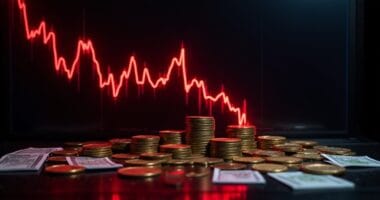The traditional relationship between U.S. Treasuries and the dollar is breaking down, leaving traders scratching their heads. Normally, both rise together as safe havens during market stress. Not anymore. Recent episodes show bonds climbing while the dollar drops – like finding penguins in the Sahara. Market pros blame shifting central bank policies and America’s fiscal health for this bizarre behavior. The upheaval forces investors to rethink everything they thought they knew about market dynamics.

Most investors have long viewed U.S. Treasuries and the dollar as two peas in a pod – reliable safe havens that typically surge together when markets get messy.
It’s been a pretty simple equation: trouble hits, investors flee to bonds, bond prices rise, yields drop, and the mighty dollar climbs. That’s just how things work. Or used to work, anyway.
Lately, this time-tested relationship has gone haywire. In several recent episodes, safe-haven bonds have soared while the dollar has done precisely the opposite of what everyone expected – it’s fallen.
This isn’t supposed to happen. It’s like seeing penguins in the desert or politicians keeping their promises. During financial crises, investors typically seek out assets with high liquidity for protection. Investors often turn to defensive stocks in sectors like food and healthcare for added stability.
The traditional pattern made perfect sense. When global investors got spooked, they’d pile into U.S. Treasuries and other safe-haven bonds like German Bunds. The bid-ask spread typically narrows during these periods of increased trading activity.
During market panic, investors reflexively sought shelter in trusted bonds like U.S. Treasuries and German Bunds.
This rush of capital into dollar-denominated assets naturally pushed up the greenback’s value. The relationship was particularly strong during major crises like the 2008 financial meltdown and the COVID-19 panic.
But markets, like teenagers, don’t always follow the rules. Sometimes bonds surge while the dollar sinks, leaving traders scratching their heads.
The culprits? Everything from shifting central bank policies to concerns about America’s fiscal health. Some non-U.S. investors are even hedging their currency risk, which dampens the dollar’s usual safe-haven boost.
This breakdown isn’t just academic – it’s causing real headaches for asset managers who built strategies around the old correlations.
When traditional relationships fall apart, risk management gets trickier. It’s like trying to navigate with a compass that suddenly points south instead of north.
The silver lining? Markets still have other safe havens. Gold shines bright when bonds and currencies get weird.
The Japanese yen often marches to its own beat. And smart investors know that diversification matters more than ever when old patterns break down.
In today’s markets, assuming anything is “always true” is about as wise as texting while skydiving.





